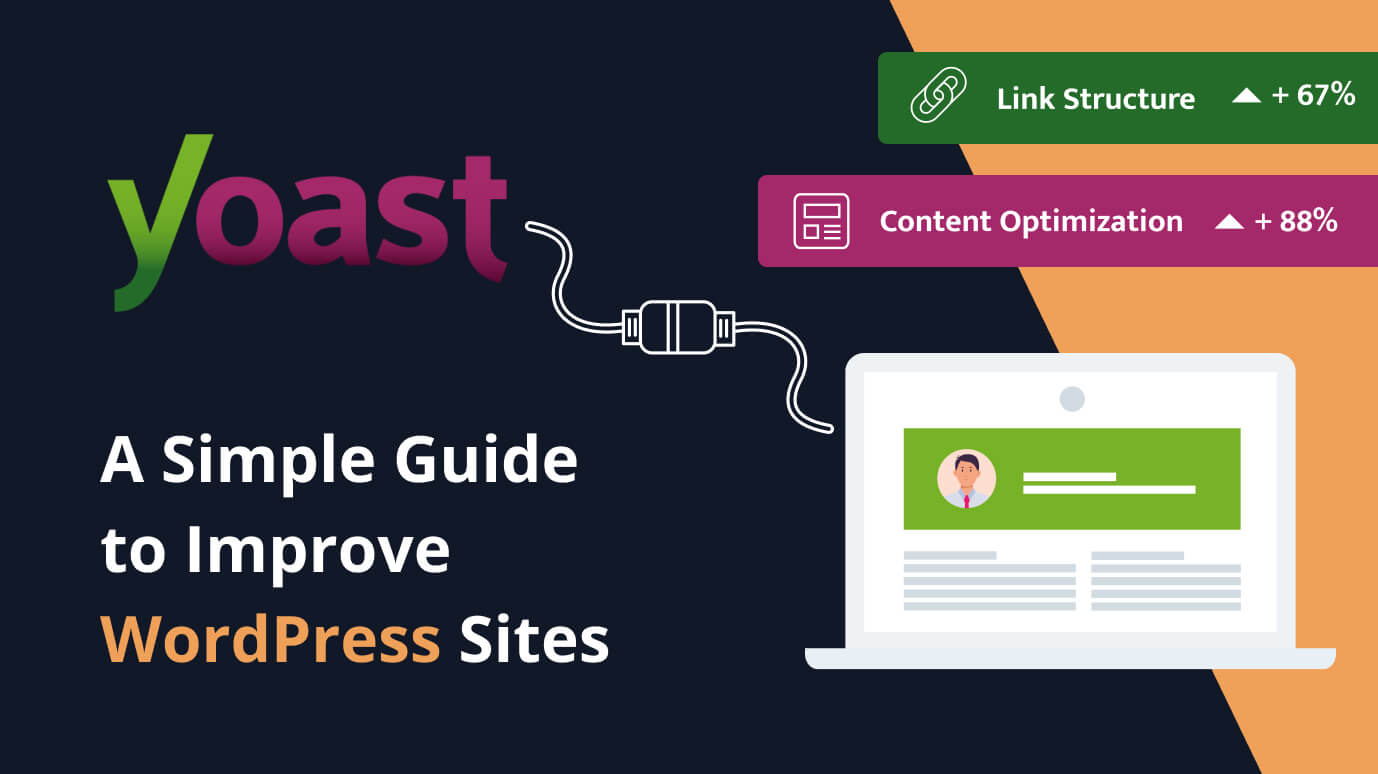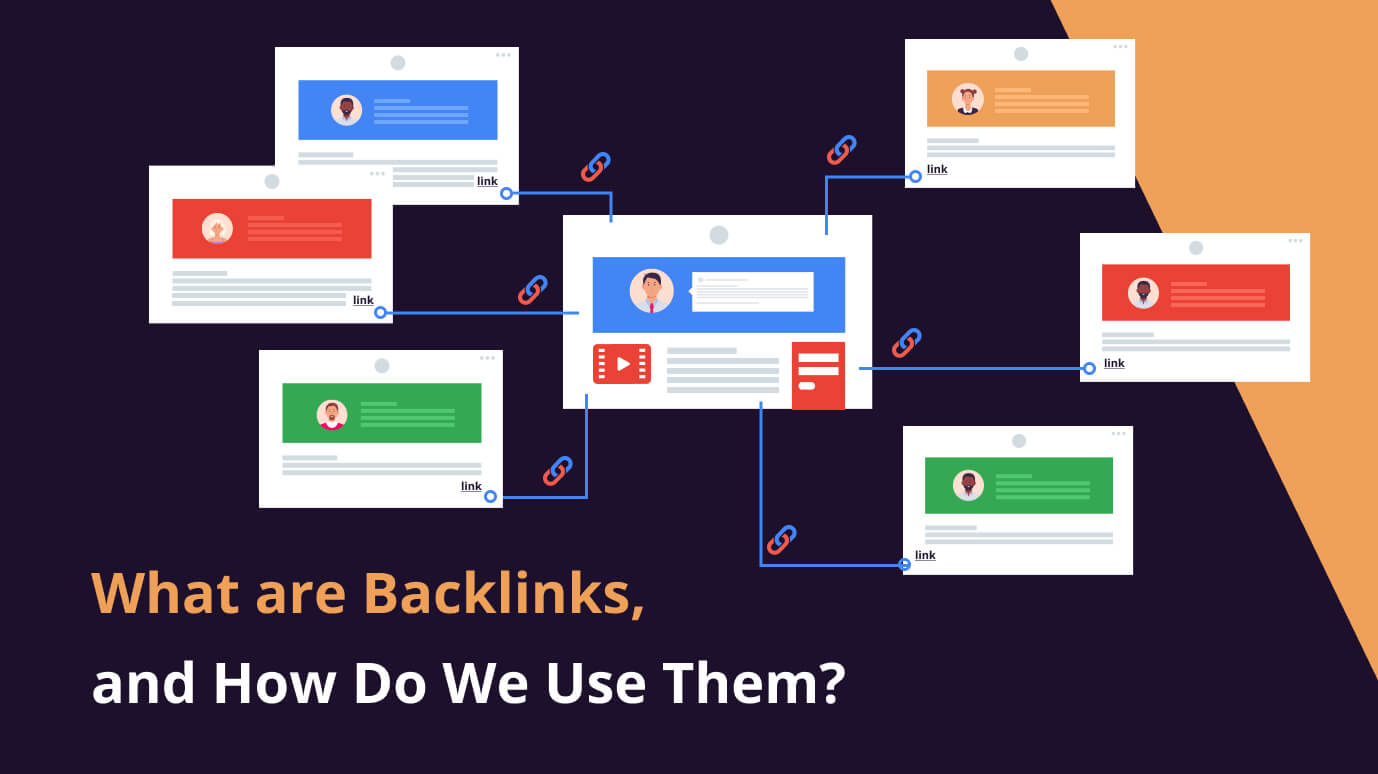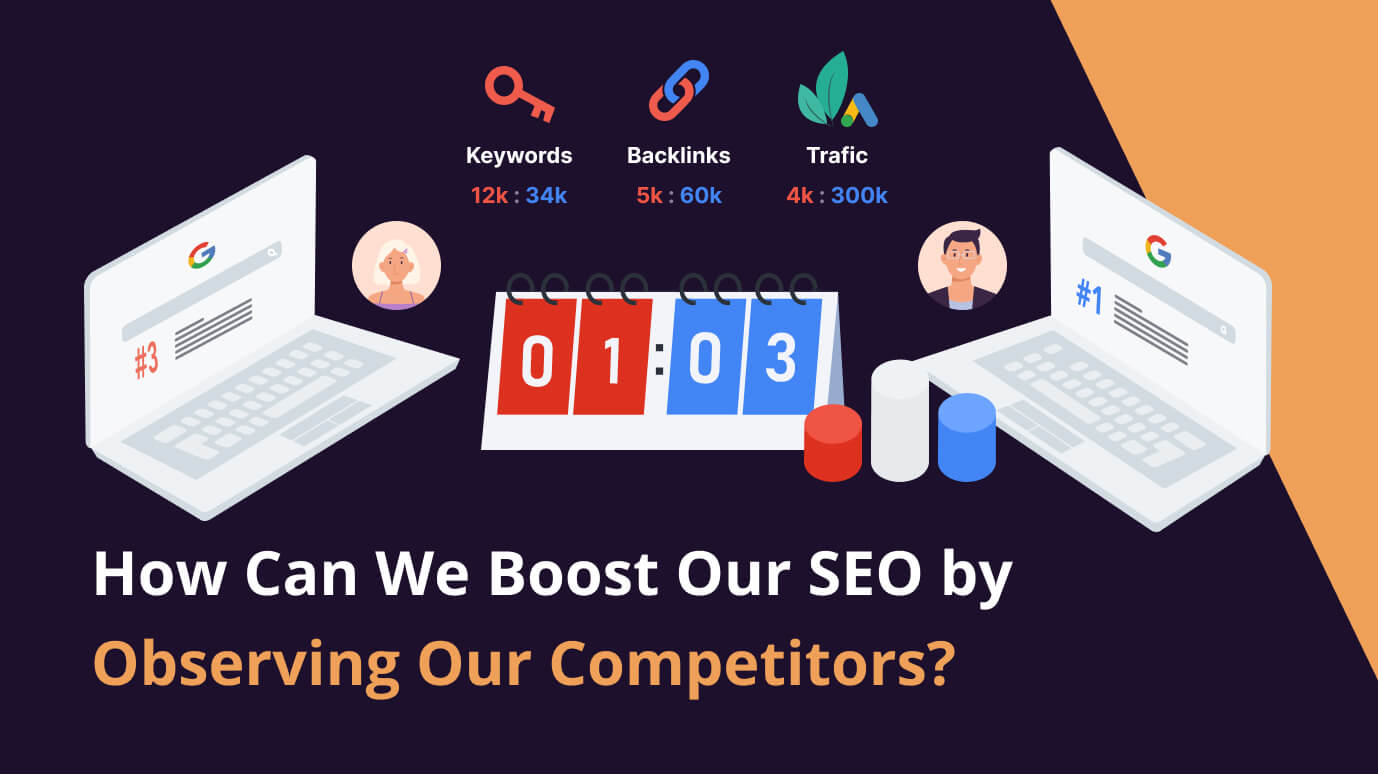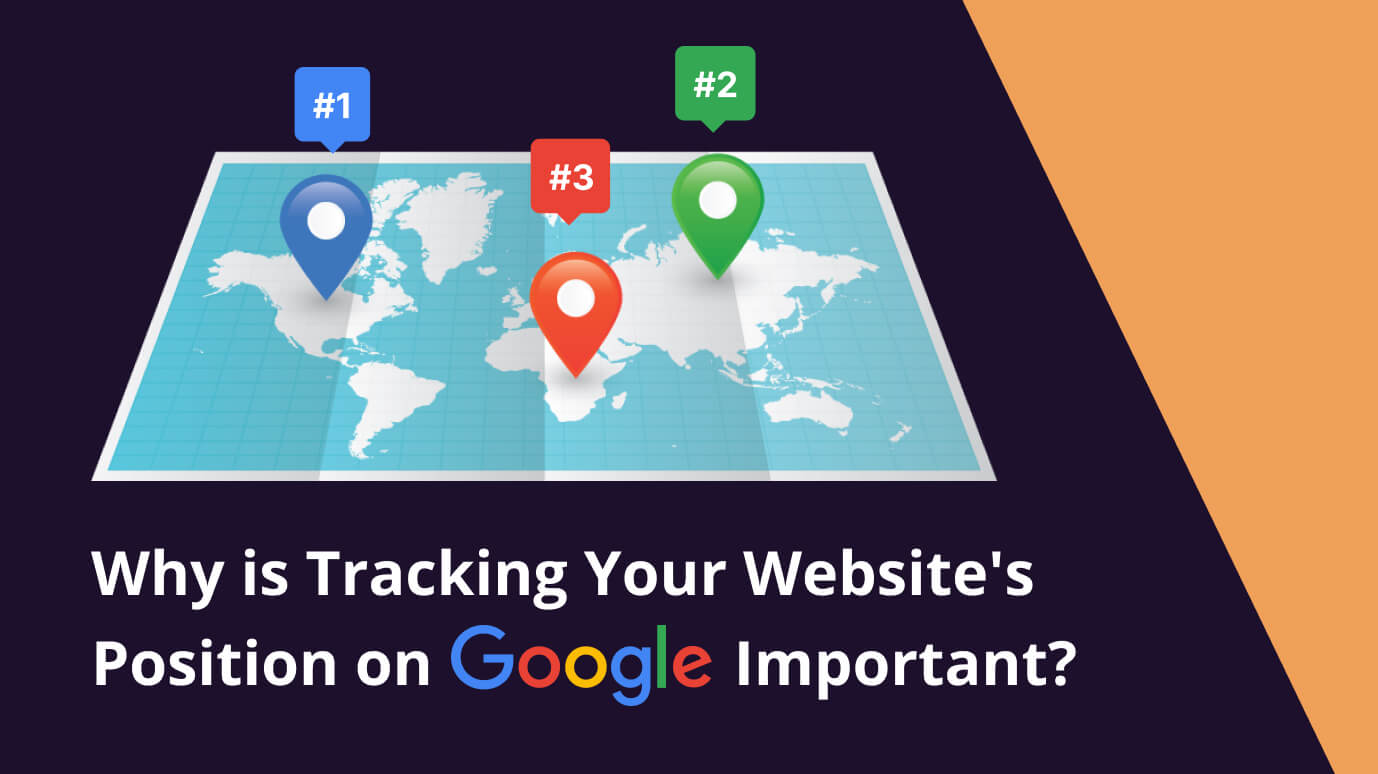
 13 min read
13 min readSEO Tracking for Beginners: A Comprehensive Guide
Introduction to SEO Tracking
SEO tracking involves regularly checking a set of metrics to evaluate a website’s performance in search engine results. Some of the most widely adopted metrics include keyword rankings, organic traffic, conversions, and referring domain growth. Tracking the right metrics is crucial for SEO success.
Besides monitoring your own website’s key metrics, it’s also useful to see how your competitors are performing on the same metrics. Identifying their successful tactics can provide insights that you can incorporate into your own strategy. For deeper insights, better data, and competitor analysis, tools like Seodity are recommended.
5 Key SEO Metrics
While there are numerous metrics and KPIs you could track to evaluate your website's SEO performance, focusing on a select few can provide actionable insights and guide your strategy effectively. Here are the five key SEO metrics that you should prioritize.
Keyword Rankings
Keyword ranking refers to the position where your page shows up on the search engine results page (SERP) for a specific keyword. It is similar to a spot on a list, and naturally, you want your page to be as high up on that list as possible. The higher you rank, the more visitors you can attract to your site. Monitoring keyword rankings is a crucial aspect of SEO because fluctuations can indicate the effectiveness of your strategies. If your keywords slip lower in the rankings, it could result in decreased web traffic. Conversely, climbing higher in the rankings is a clear sign that your SEO efforts are yielding positive outcomes.
Tracking keyword rankings requires specialized tools to monitor these changes over time. For example, Seodity Rank Tracker allows you to create a list of keywords and automatically monitor their placement in the SERPs across various locations, covering both mobile and desktop searches. When setting up a project, tools will often suggest keywords for tracking based on your site's content. It's essential to choose keywords that are significant to your business and target audience, rather than attempting to track every possible keyword variation.
Overall, effective keyword ranking tracking is essential for any SEO strategy aiming to enhance visibility and drive organic traffic to a website.

How to Track Keyword Rankings?
Here's how you can effectively monitor your keyword rankings:
- Use a Rank Tracking Tool: Tools like Seodity Rank Tracker can be invaluable. These tools allow you to create a list of important keywords and automatically monitor their positions in SERPs across different locations and devices. For instance, Seodity provides an overview report that shows your keywords' performances over time, making it easier to track trends and identify areas of improvement.
- Set Up Your Keywords: When setting up a project in a rank tracking tool, you can select keywords relevant to your business. It's crucial to focus on target keywords that are pivotal to your webpages and your overall SEO strategy. Many tools will suggest keywords based on your content, helping streamline the process.
- Monitor Competitor Keywords: Understanding where your competitors rank for specific keywords can offer strategic insights. Many tools allow you to track competitor rankings, enabling you to evaluate their tactics and adapt accordingly. This comparison can highlight opportunities and threats in your SEO landscape.
- Regularly Review Reports: Most rank tracking tools offer detailed reports and graphical representations of your keyword rankings over time. Regularly reviewing these reports will help you spot trends, whether positive or negative. For instance, a consistent rise in rankings indicates your strategies are working, while a drop might require re-evaluation and adjustment of your tactics.
- Add and Update Keywords as Needed: SEO is an ongoing process. Tools often feature options to add new keywords or refine existing ones. As your content evolves and market conditions change, updating your keyword list ensures you are always tracking the most relevant terms. Seodity gives you recommendations automatically with keywords worth tracking for your website.

Organic Traffic
Organic traffic refers to the number of visitors who land on your website through unpaid search results. This metric is crucial as it directly measures the success of your SEO efforts. Essentially, if your website is listed higher on search engine results pages (SERPs), you're likely to attract more organic traffic. This is a key indicator that your SEO strategies are effective, as increased organic traffic generally means more potential customers or readers are finding and visiting your site.
Tracking organic traffic provides insightful data about your website's performance in search engines. Google Search Console is an excellent free tool for this purpose. It gives you an overview of the total number of clicks your site receives from Google searches, and you can also see the performance of specific pages and keywords. Google Analytics, when integrated with Google Search Console, provides even more robust data, including user behavior once they arrive on your site.
For a more detailed analysis, you might consider using advanced SEO tools like Seodity Organic Traffic. This tool offers functionalities for checking organic traffic as well as keyword gap and intersection. This allows you to identify opportunities for improvement and understand where you stand in comparison to competitors.
Tracking organic traffic also helps you identify which keywords drive the most visitors to your site. Understanding these keywords allows you to focus your SEO efforts more effectively. For instance, if you notice that certain keywords are performing exceptionally well, you might decide to create more content related to those topics or enhance existing content to target those keywords more aggressively.

How to Track Organic Traffic?
Tracking organic traffic is essential to evaluate the success of your SEO efforts and understand how your website performs in search engine results. Organic traffic refers to the visitors who find your site through unpaid search results, reflecting the effectiveness of your SEO strategy. Here’s how you can efficiently monitor organic traffic:
- Google Search Console: This free tool from Google provides an overview of the total number of clicks your site receives from Google searches. It allows you to see which specific pages and keywords are driving traffic, helping you gauge your website’s performance.
- Google Analytics Integration: By integrating Google Analytics with Google Search Console, you can access more comprehensive data, including user behavior on your site. This integration helps you analyze how visitors interact with your content, offering deeper insights into your SEO efforts.
- Tools like Seodity Organic Traffic: For a more detailed analysis, consider using advanced SEO tools like Seodity Organic Traffic. This tool provides functionalities such as overlaying competitor data, comparing trends, and pinpointing exact days of traffic spikes or drops. These features allow you to correlate changes in traffic with specific events, like Google algorithm updates or new content publications. With Seodity's intuitive interface, you can easily connect various data points and gain comprehensive insights into your website's performance. Additionally, Seodity offers robust reporting capabilities, helping you monitor your site's organic growth and identify key opportunities for optimization.
- Identifying Top Performing Keywords: Understanding which keywords drive the most organic traffic to your site enables you to focus your SEO efforts effectively. By identifying high-performing keywords, you can create more content targeting these terms or optimize existing content for better search rankings.
- Observing Trends Over Time: Monitoring organic traffic trends over an extended period helps you recognize seasonal patterns and the impacts of marketing campaigns. This historical data can inform future SEO strategies and content planning.
Conversions
Conversions measure the effectiveness of your SEO efforts in turning website visitors into valuable actions, such as sales, sign-ups, or other goals crucial to your business. This metric helps you understand the return on investment (ROI) of your SEO strategy. While attracting traffic to your site is essential, ensuring that visitors take desired actions is what ultimately drives business success.
Tracking conversions can be more complex than other SEO metrics because it involves understanding user behavior and the specific actions they take on your site. These actions could include completing a purchase, filling out a contact form, downloading a resource, or signing up for a newsletter. The end goal is to translate organic traffic into tangible outcomes, highlighting the true value of your SEO efforts.
To track conversions, typically website analytics tools like Google Analytics 4 (GA4) are used. These tools require a custom setup for each type of conversion you want to monitor. In GA4, conversions are referred to as "key events," which track specific user interactions. You can set up these events in the admin panel of your site and mark them as key events. For example, if a user completes a purchase, GA4 records this action as a conversion.
How to Track Conversions in Google Analytics 4 (GA4):
- Create an Event: In GA4, navigate to the admin panel and create an event that represents the action you want to track, such as a purchase or form submission.
- Mark the Event as a Conversion: Once the event is created, mark it as a key event to ensure it is tracked as a conversion in your reports.
- Analyze the Data: Go to the Advertising panel in GA4 to see conversions from organic traffic specifically. This helps you evaluate the effectiveness of your SEO strategy in driving valuable actions.
Consistently monitoring and optimizing for conversions not only helps you measure the success of your SEO efforts but also ensures that your website delivers the desired business outcomes. It provides a comprehensive picture of how well your SEO strategies are performing in driving valuable actions and helps you make informed decisions to enhance your site's overall effectiveness and ROI.
Referring Domains
Referring domains are the individual websites that link back to your website. These backlinks are critical for building your site's authority and improving its visibility in search engine results. Monitoring referring domains gives you a clear picture of how your backlink profile is expanding over time and the quality of sites that are linking to you.
A healthy link profile consists of multiple high-quality links from diverse domains. The more authoritative and varied these referring domains are, the better it is for your SEO. Search engines like Google use backlinks as a significant ranking factor. Therefore, sites with a robust backlink profile are more likely to rank higher in search results.
To track referring domain growth, you can use tools like Seodity Backlinks module. These tools provide detailed reports on the number of referring domains, the quality of these domains, and changes in your backlink profile over time. Ideally, you should aim to build as many or more links from unique domains than your competitors to increase your chances of ranking higher.
Regularly monitoring your referring domains helps you evaluate the effectiveness of your link-building efforts and allows you to identify and address potential issues. For example, a sudden drop in the number of referring domains could indicate a problem that needs immediate attention.
By maintaining a strong and diverse link profile, you enhance your site’s authority and improve its chances of ranking well in search engine results pages, driving more organic traffic and increasing your overall SEO performance.
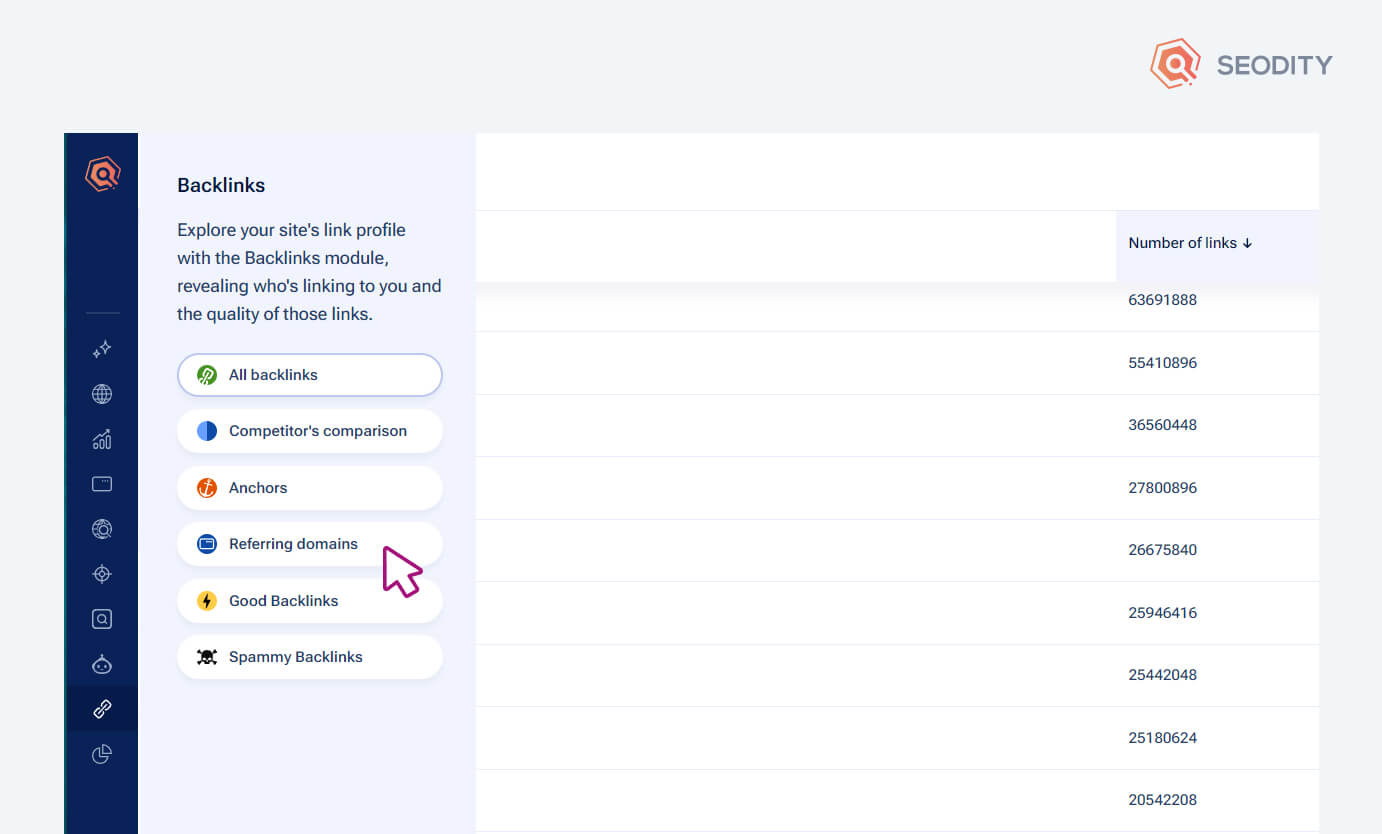
How to Track Referring Domains?
Tracking referring domains is crucial for understanding how your website's backlink profile is growing and assessing the quality of the links you are acquiring. Referring domains are the individual websites that link back to your site, and an increase in these links, especially from authoritative sources, can significantly boost your SEO performance. Here’s how you can effectively monitor referring domains:
- Use SEO Tools: Utilize tools like Seodity, Moz, or SEMrush to get detailed reports on the number and quality of referring domains. These tools provide invaluable insights, such as the authority of the sites linking to you, which can help you gauge the strength of your backlink profile.
- Monitor Growth Trends: Regularly check the growth in the number of referring domains. A steady increase usually indicates successful link-building efforts. Conversely, a sudden drop might signify lost backlinks, which warrants further investigation.
- Assess Link Quality: Not all links are created equal. Tools like Ahrefs allow you to evaluate the quality of your referring domains based on metrics like Domain Rating (DR) and Page Rating (PR). Focus on acquiring backlinks from high-authority websites to enhance your own site's credibility.
- Analyze Competitors: Compare your referring domains with those of your competitors. This can provide insights into their link-building strategies and potentially reveal new opportunities for gaining high-quality backlinks.
- Identify Toxic Links: Sometimes, your site may acquire backlinks from spammy or low-quality sites. Use SEO tools to identify these toxic links and disavow them if necessary to protect your site's reputation and SEO performance.
By consistently tracking referring domains, you can ensure that your backlink profile remains strong and diverse, which is critical for maintaining and improving your site's authority and ranking in search engine results pages. This proactive approach will ultimately lead to better visibility, more organic traffic, and enhanced overall SEO performance.
Technical SEO Issues
Technical SEO issues encompass a variety of potential obstacles that can impede search engines like Google from finding, crawling, and indexing your website effectively. Addressing these issues is crucial for maintaining a healthy SEO environment and ensuring that your site appears correctly in search results. Technical SEO covers numerous aspects, including site speed, mobile-friendliness, and the proper use of structured data.
By monitoring and resolving these technical SEO issues, you can enhance your site's overall performance and ensure that it meets the technical standards required by search engines.

How to Track Technical SEO Issues?
Tracking technical SEO issues is essential for maintaining your website's health and ensuring optimal performance in search engine rankings. Here’s how you can effectively monitor and address these issues:
- Use SEO Auditing Tools: Tools like Seodity On Site Audit, SEMrush, and Google Search Console are invaluable for identifying technical SEO issues. They provide comprehensive reports on various aspects of your site, including crawl errors, indexability, site speed, and more.
- Schedule Regular Audits: Regular site audits help detect new issues that may arise. Tools like Seodity On Site Audit let you schedule regular crawls, ensuring continuous monitoring of your site’s health.
- Analyze Crawlability Reports: Check for crawl errors reported by tools like Google Search Console. Issues such as broken links, server errors, and robots.txt blocks can prevent search engines from effectively crawling your site.
- Monitor Site Speed: Tools like Google PageSpeed Insights provide detailed analyses of your website's load times, identifying specific elements that need optimization.
- Ensure HTTPS Implementation: Verify that your site is served over HTTPS by checking the URL in the browser bar. Tools like SSL Labs can evaluate your HTTPS setup for security vulnerabilities.
- Implement Structured Data: Use Google’s Structured Data Testing Tool to validate any schema markup on your pages. Properly implemented structured data helps search engines understand your content better.
Tracking Competitor SEO Metrics
Understanding how your competitors are performing on key SEO metrics can provide valuable insights that help refine and enhance your own strategy. By monitoring competitors' SEO, you can identify successful tactics they use and potentially adapt them for your benefit. Here’s a guide on how to effectively track competitor SEO metrics:
- Add Competitors in Your Tracking Tool: When you set up a new project in tools like Seodity, include competitors' URLs to monitor their performance metrics. This setup allows you to compare keyword rankings, traffic, and backlink growth seamlessly.
- Regular Reporting: Generate regular reports to analyze competitors’ SEO performance over time. This ongoing analysis helps you identify emerging trends and tactics that could be beneficial to incorporate into your strategy.
By diligently tracking competitor SEO metrics, you can gain a competitive edge, uncover opportunities for growth, and continuously optimize your SEO strategy for improved results.
Conclusion
SEO tracking is a vital aspect of ensuring that your website performs well in search engine results and continues to attract the desired audience. By focusing on key metrics such as keyword rankings, organic traffic, conversions, referring domains, and technical SEO issues, you can gain a comprehensive understanding of your website’s strengths and areas for improvement. The right tools, like Seodity, Google Search Console, and Google Analytics, can provide actionable insights that drive your SEO strategy forward.
Regularly monitoring these metrics helps you stay informed about your website's performance and allows you to make data-driven decisions that enhance visibility and user engagement. Additionally, keeping an eye on competitor SEO performance offers valuable insights that can help you refine your strategy and gain a competitive edge.
Implementing a systematic SEO tracking approach will not only improve your site's ranking potential but also ensure that your SEO efforts translate into tangible business outcomes. Maintaining a robust and proactive SEO strategy is essential for long-term success in the ever-evolving digital landscape.
Further Reading
If you are interested in such topics or just starting in SEO, you can read our SEO Beginners' Guide.

Co-founder of Seodity
.svg)







